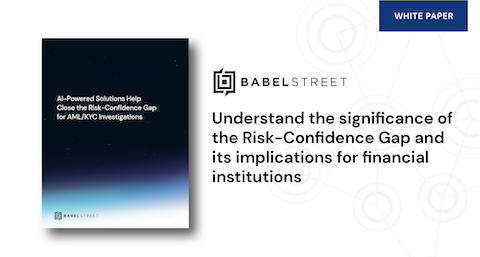New paper: AI-Powered Identity Intelligence Closes AML/KYC Risk-Confidence Gap

AI-powered identity intelligence solutions address the Risk-Confidence Gap, or the chasm between the amount of data FIs must examine to meet AML/KYC mandates, and the resources available to analyze it.
Is your financial institution stuck in the Risk-Confidence Gap?
The Risk-Confidence Gap is the widening divide between the amounts and types of data FIs must examine to comply with anti-money laundering/know your customer (AML/KYC) mandates, and the resources they have available to confidently analyze and act on that information. The Gap leaves FIs vulnerable to fines and penalties for failure to adequately perform AML/KYC processes, and to the reputational damage that can accompany that failure. As discussed in our white paper, the Risk Confidence Gap also causes unnecessary investigative costs, and can lead to businesses losses when banks take too long to clear new customers for onboarding.
What causes the Risk-Confidence Gap?
A combination of escalating data volumes and increasing data complexity causes the Risk-Confidence Gap.
Data that underpins the identity intelligence needed for optimal AML/KYC processes runs the gamut from government-issued IDs to banks’ internal transaction histories. It can include mountains of corporate beneficial ownership information, demographic data, geographic data, government-issued IDs, media coverage, fund sources, and more.
But it’s not the sheer volume of data to be examined that proves problematic for FIs — it’s the complexity of that data. Intricate data sets with hard-to classify fields, multilingual data, and data blind spots (areas within a dataset where information is missing or inaccessible) must all be accommodated.
The digital accessibility of all this data is a double-edged sword for FIs. It contains all the information needed for improved insight, but that information is buried in mountains of irrelevant material that FIs must spend time and money analyzing. And these analyses aren’t just done once. To comply with AML/KYC regulations, FIs must examine this data at customer onboarding, then periodically throughout the customer lifecycle.
Outdated technologies exacerbate the problem
FIs’ over-reliance on outdated screening technologies and rules-based processes that require significant human intervention intensify the Risk Confidence Gap. In a recent Babel Street survey of 100 AML/KYC professionals, respondents reported that more than half of new clients required between three days and a week to be cleared for onboarding. Suboptimal processes for name-matching and entity resolution cause the delay — returning a glut of false positives requiring significant human remediation to clear.
Exacerbating the lag are existing processes for adverse media screening (AMS) — or screening of reputable news sources for adverse mention of a client or prospect. Professionals surveyed reported that, in 45% of cases, AMS alone takes up to two hours per prospect. In 22% of cases, it takes between one-half of a workday and one full workday.
Why so long? As with name matching and entity resolution, survey respondents report spending too much time sorting through AMS false positives. In fact, false positives account for more than 43% of all articles returned during AMS investigations. (A “false positive” in these instances means the risks uncovered in these analyses are irrelevant to the financial institution, or that the AMS system matches to an entity that is not the subject of the investigation.)
Disjointed tool sets and databases further stall AML/KYC processes. For sanctions and watchlist screenings, banks reported using risk intelligence databases including World-Check by LSEG, Dow Jones Risk & Compliance, Moody’s, and Accuity. For AMS, banks use everything from common search engines (Google, Bing, Yahoo), to LexisNexis, Factiva by Dow Jones, Media Check by LSEG, and custom-built tools. No wonder, then, that survey respondents reported uncertainty in both merging and distinguishing between different identity sources, and enduring time-consuming “swivel-chair processes” — or workflows that require data to be manually entered into multiple systems.
New technology helps close the Gap
What can we extrapolate from the responses to the Babel Street study? AML/KYC determinations take too long, are based on incomplete or disconnected data, and leave investigators lacking confidence in the decisions made about customers.
Change is needed. But FIs cannot implement new methodologies using manual processes and siloed, legacy systems. Rather, they require nimble, AI-powered identity intelligence solutions to deliver a comprehensive picture of each entity. These solutions must help FIs more quicky screen applicants, monitor individuals who pose risk, and efficiently process multilingual data. Only with these solutions will FIs obtain the identity intelligence they need to spot the potential risks associated with each customer — and act accordingly.
According to Babel Street’s analysis of the AML/KYC processes used in banks surveyed, the right identity intelligence capabilities can also dramatically reduce the time spent per entity discovery and resolution, concurrently reducing the cost of these investigations. In addition to costing less, these analyses are much deeper than those currently conducted. While human investigators might search 100 sources per entity, the study notes that the best identity intelligence solutions search between 20,000 and 50,000.
Register to read our white paper to learn more about the Risk Confidence Gap, and how new technology can help close it.
Disclaimer:
All names, companies, and incidents portrayed in this document are fictitious. No identification with actual persons (living or deceased), places, companies, and products are intended or should be inferred.